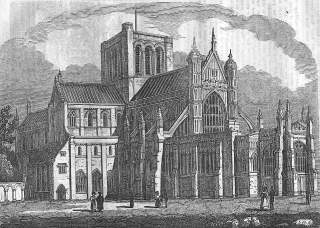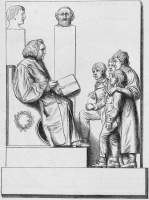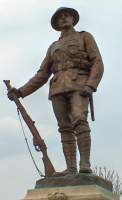 .
.
'The Cathedral of Winchester occupies a distinguished place amongst the sacred edifices of this country. The vastness of its dimensions, the imposing character of its architectural decorations, and the solemn grandeur of its effect as a whole, sufficiently establish its claim to admiration.' - early 19th C guidebook.
The cathedral as a whole was started in 1079, and the early Norman crypt and transept survive. It was extended to give a large retrochoir in the 13th C, and the nave extensively remodelled in the 14th C. Various fiddlings and additions since then, including in the 19th Century.
The Cathedral has a good crop of funerary monuments, from early mediaeval through to Victorian and later. We start of course with the 19th Century works, going from the west door entrance anticlockwise, via south aisle, south transept, south choir and retrochoir, the choir and altar space itself, and then forwards via north choir, transept and north aisle. We have opportunity to see works by about a dozen identifiable sculptors, including Chantrey, Theed, Weekes and John Bacon Junior.
We commence with a few monuments by sculptors I have not identified. Down the south aisle, we may note two small sailors in stone adorning a plaque to William Carmichael Forrest (d. 1881) and a lively little mermaid on the monument to William Gerard Byron (d. 1885). And a little beyond, below a window to the non-commissioned officers of the Hants regiment in the South African War (1899-1902), is excellent work showing angels in inlaid marble with blue coloured wings and painted faces, very sweet in the style of Waterhouse. Pairs of angelic heads behind, and dark blue mosaic background. But who did it? Whoever it was clearly also the hand that produced the parallel work in the North Transept, a panel to Frederic Preston Joy (d. 1913).
Nearby, a recumbent figure of Bishop Edward Harold, (d. 1906), with very detailed surface carving, and an old rather than characterful face. Note good dragon at feet, and the half dozen or so little saints in niches on the bier.
Next the important and identifiable monument to George Prevost, by Francis Chantrey. A fine mourning delicately draped female figure in marble.
And another unidentified one, the excellent memorial to the Portal family, with portraits of the two most illustrious members in stone, and a full sized angel with uplifted wings, long hair and a symbolist face of art nouveau date. The arresting picture is completed with good drapery, clinging on the body, swirling round the feet.
In the South Transept, the chief monument is that of Samuel Wilberforce (bishop until 1873), with an excellent recumbent stone effigy - with face dramatised by the natural lines in the marble - borne by 6 kneeling angels in alabaster. Note too the good eagle at the foot, and the two charmingly sorrowful angles at the head. All this lies within a shrinelike structure with a variety of little portrait heads, half-figures of angels, basal lions, and allegorical figures at the corners - of these latter, the best is Fortitude, a fierce woman attired in a lionskin. Prudence is shown crushing a snake. Justice has the usual accoutrements, and inspiration had clearly vanished with the feebly conventional Faith. The ensemblage as a whole by H. H. Armitage, 1878.
 Flaxman's plaque of Joseph Warton.
Flaxman's plaque of Joseph Warton.
We have a munument by John Flaxman - the frieze to Joseph Warton (d 1800) - a marble scene of the subject, wigged and seated, reading to a group of boys. Busts of Homer and Aristotle behind.
Nearby, a composition by William Theed, three small marble female figures as part of the monument to David Williams (d. 1860), with simple drapery treatment, and rather thick-necked ideal figures which rather hark back to the earlier part of the 19th Century in style. And a certain E. Richardson was sculptor of the marble relief of a mourning angel for Frederick Mills (d. 1854/55). Three or four other smaller monuments of 19th C date in the same area are by unidentified artists.
A bit further on in the Transept though, is the full size kneeling marble statue of Brownlow North by Chantrey, dating from 1873. Heavy drapes, and a stern face - an interesting contrast to the feminine figure in the Prevost Memorial already noted.
At the east end, the marble effigy of Charles Richard Sumner, with highly worked face, and much drapery, is by Weekes. And the sole painting we note in the Cathedral, in the Bishop Langton Chantrey, is a triptych of the Adoration - is this the picture by Benjamin West which originally hung over the altar, and was removed as part of the changes made when the altar-screen was restored in the 1880s-90s?
Which brings us on to the altar screen, then - big, ornate stone and tracery with some 19 principle figures, and about 30 small ones. The crucifixion itself was the work of Farmer and Brindley, under the direction of G F Bodley, and I think the Holy Family and female saints surrounding it. Less sure about the rest, which was completed earlier on (1888) under the direction of J. D. Sedding. At least a couple of the figures, including that of Isaak Walton, are by the sculptor Mary Grant.
In the north transept, a recumbent statue of Frederic Iremonger, prebendary (d. 1820), a simple, shrouded stone figure. And a fine, noble bronze of General Medvers Henry Buller, dating from 1910 and the work of the Australian sculptor Bertram Mackennal. A further excellent work, affixed to a pillar, is the monument to Frederick Turner, who died in Bombay in 1856. A high relief sculpture showing suitably exotic palm trees, a fallen pillar, and domes of the city in the middle distance, by the less than familiar sculptor Thomas Bacon.
Along the North Aisle, we have already noted the Preston Joy panel. The Epiphany Chapel has several stained glass figures of note, in the style of Alfred Parsons with Morris-style backgrounds: the best is an Eden scene with the Serpent.
The novellist Jane Austen died in Winchester, and is buried in the Cathedral with a commemorative window by C. E. Kempe (1900), with a variety of saints. Note below, the small work by Adrian Jones (of the Quadriga at Hyde Park Corner) - a scene in bronze of a weary soldier ahorse and companion, in memory of Charles Berkeley Pigott (d. 1897). And we end the 19th C work by noting the marble plaque to John Littlehales (d. 1810). It shows the dying subject in the arms of Christ, frondy tree behind - the prolific John Bacon Jun. was the sculptor.
A briefer note of earlier sculpture. Again going round clockwise, we can note the following, starting in the south aisle of the nave:
Thomas Cheyney (d. 1760) - a roundel in red marble shows a female angel letting the deceased out of a coffin, while a cherub blows his trumpet behind. Above, a rising phoenix. Left and right, small statues of lounging girls, bearing respectively an anchor and book, and a mirror and rope. Characteristic round faces of the period, and rather complacent look.
Richard Willis - a full sized figure reclines on a bier surrounded by the front of Greek temple in ostentatious marble. Signed by the important 18th Century sculptor Henry Cheere.
The Chantrey chapel of William of Wykeham, bishop 1367-1404, founder of an Oxford college (at least two more were founded by bishops here), and Winchester college. A recumbent painted stone figure with brood of angels and monks clustered at head and foot respectively. Wall with tiers of saints, full figure, in stone, difficult to see properly. And nearby the Chantrey Chapel of William of Edington, bishop 1346-66. A better medieval marble figure, stylised round face, characteristically Norman look.
On to the transept, right hand side:
Note the excellent Chantrey Chapel to Bishop Fox (bishop 1501-28), with a grim recumbent statue of a corpse with skin tight against bones, face looking in agony, stark, grim, powerful. The whole behind iron bars. Around, very ornate shrine, screen in stone with 14 small 19th C figs, swanlike griffins high up above. Also notable is the big monument to John Clovery, a standing alabaster figure in splendrous clothing and wig, standing proudly in an arched doorway, with spear and jauntily cocked elbow. Stylish, late 17th Century work. And an early statue of a headless female in stone dating from the 13th C statue, one of four from Priory, much worn, but still showing an elegant sweep to the drapes on the girlish figure.
In the East End, the Lady Chapel has early 16th C stalls, and wall paintings, though as these are covered with copies on wood, there is no saying how close they are to the originals. The Guardian Angels chapel has lively mediaeval angel heads dating from 1240 on the vault, by Master William, the Kings Painter, restored 1959-60. In the chapel, a bronze of Richard Weston, and outside it, a granite portrait of Aylmer de Valence, a medieval bishop holding a heart.
There are two rather magnificent freestanding Chantrey chapels, with excellent tracery. First is Cardinal Beaufort (bishop 1404-47), with a painted recumbent stone effigy with a cardinal's hat. Rather stiff drapes and cushion, and an unsympathetic treatment of the face. The second is that of Bishop Waynflete (1447-86), again painted, much more careful and ornate drapes.
On the floor, Peter de Roche, another bishop, unprotected on a low plinth, in a flattened idiom common in the 13th and 14th C. And Sir Arnaud de Gaveston (d. 1310), a Norman crusader, face sketched in rather than carved, cross-legged, and as usual, with feet resting on a beast, in this case a rather spirited lion. At the top, remains of two angels, the legs and lower torso of one being an unusually nice depiction of the feminine form. The floor itself shows an expanse of 13th C tiles, showing stars, floral, etc but no figurative designs.
The underpinning of the sinking east end of the Cathedral at the beginning of the 20th C is marked by a small modern bust of the diver concerned, William Walker, signed G. W. 2001.
Wood chests up above on both sides of stone screens above the alter contain bones of 7th - 11th C kings. The chests bear mediaeval carvings of angels, griffins, and cherubs.
Proceeding to the north transept, the Holy Sepulchre chapel has real 12th C wall paintings - busy scenes with figures crouching in mediaeval fashion to fit into the space they occupy.
We may note the big showy painted monument to Edward Cole, Mayor (d. 1617), for its gargoyle heads and little griffins in high relief, and strange grotesque harpies.
The Crypt contains a typical Anthony Gormley bronze male figure called Sound II.
Thence back to the other part of the Transept and through to the west end of the Cathedral via the north aisle. Fine marble monuments to Edward Montagu and family (d.1776) - two female figures and an urn, and Col James Morgan (d.1808) - a mourning woman, with behind, cannon, elephant and an urn on a plinth. And the large and characterful monument to Villiers Chernocke (d.1779), with a scene of a woman with three infants, and a female representation of blind justice, and nice palm fronds above.
And finally, note the early sculpture on the 12th C black marble font, which shows a frieze of the miracles of St Nicholas. A procession of figures, with a good ship, castle or cathedral, and roundels of birds and beasts, reminiscent of medieval tile designs, though not ones in this cathedral.
Outside, high up on the exterior of the Cathedral is a stone statue of William of Wykeham, of no great pretension. And in the grounds, is a memorial to the King's Royal Rifle Corps, with a bronze statue of a rifelman standing in informal pose. Decent work, by the sculptor John Tweed.
 Monument to the King's Royal Rifle Corps, by John Tweed.
Monument to the King's Royal Rifle Corps, by John Tweed.
Winchester // Sculpture in England // Sculptor pages // Introduction to church monuments
Visits to this page from 23 Nov 2011: 2,269